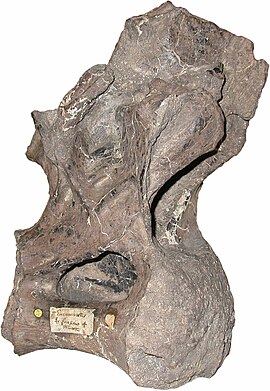Eucamerotus
Stratigrafický výskyt: Spodní křída (asi před 130 miliony let) | |
|---|---|
 | |
| Vědecká klasifikace | |
| Říše | živočichové (Animalia) |
| Kmen | strunatci (Chordata) |
| Třída | plazi (Sauropsida) |
| Nadřád | dinosauři (Dinosauria) |
| Řád | plazopánví (Saurischia) |
| Podřád | sauropodomorfové (Sauropodomorpha) |
| Infrařád | sauropodi (Sauropoda) |
| Nadčeleď | Titanosauroidea |
| Rod | Eucamerotus Hulke, 1872 |
| Typový druh | |
| Eucamrotus foxi Blows, 1995 | |
| Některá data mohou pocházet z datové položky. | |
Eucamerotus („s dobrými komorami“; což odkazuje k dutinám v obratlech) byl pochybný rod sauropodního dinosaura z kladu Titanosauria, žijícího v období spodní křídy na území dnešního ostrova Isle of Wight při jižním pobřeží Anglie.[1]
Historie
[editovat | editovat zdroj]Tento taxon byl pojmenován na základě objevu neurálního oblouku obratle s označením NHMUK R.2522. Fosilii objevil v lokalitě zátoky Brighstone Bay lékař a amatérský paleontolog William D. Fox, v roce 1872 o ní referoval v odborné literatuře paleontolog John W. Hulke.[2] Později byla fosilie označena za materiál příslušející k rodu Ornithopsis[3] nebo k rodu Pelorosaurus[4], v roce 2004 byla označena za nomen dubium (pochybné vědecké jméno)[5]. V roce 1995 badatel William T. Blows označil rod Eucamerotus za vědecky platný (validní) a přiřadil jej k čeledi Brachiosauridae.[6] V současnosti je však uznáváno zařazení Titanosauriformes incertae sedis (nejistá pozice v rámci kladu Titanosauriformes).[7]
Popis
[editovat | editovat zdroj]Jednalo se pravděpodobně o menší druh sauropoda, dosahujícího délky kolem 15 metrů. Tomu odpovídá také velikost dochovaných fosilních obratlů, které měří v průměru zhruba 20 centimetrů.[8] Eucamerotus byl býložravým dlouhokrkým dinosaurem, žijícím v menších stádech a spásajícím nízko a středně vysoko rostoucí vegetaci.
Reference
[editovat | editovat zdroj]- ↑ Hulke, J. W. (1879). "Note (3rd) on (Eucamerotus, Hulke) Ornithopsis, H. G. Seeley, = Bothriospondylus magnus, Owen, = Chondrosteosaurus magnus, Owen". Quarterly Journal of the Geological Society. 35 (1–4): 752–762. doi: 10.1144/GSL.JGS.1879.035.01-04.55
- ↑ Hulke, J. W. (1872). "Appendix to a "Note on a new and undescribed Wealden Vertebra," read 9th February 1870, and published in the Quarterly Journal for August in the same year". Quarterly Journal of the Geological Society. 28 (1–2): 36–38. doi: 10.1144/GSL.JGS.1872.028.01-02.15
- ↑ Lydekker, R. (1888). Catalogue of the Fossil Reptilia and Amphibia in the British Museum (Natural History). Part I. Containing the Orders Ornithosauria, Crocodilia, Dinosauria, Squamata, Rhynchocephalia, and Proterosauria. British Museum (Natural History): London, 1-309.
- ↑ von Huene, F. (1909). Skizze zu einer Systematik und Stammesgeschichte der Dinosaurier. Centralblatt für Mineralogie, Geologie und Paläontologie 1909: 12-22.
- ↑ Upchurch, P. M., Barrett, P. M., and Dodson, P. (2004). Sauropoda. In: Weishampel, D.B., Dodson, P., and Osmólska, H. (eds.). The Dinosauria (2nd edition). University of California Press: Berkeley 259-322. ISBN 0-520-24209-2
- ↑ Blows, W. T. (1995). The Early Cretaceous brachiosaurid dinosaurs Ornithopsis and Eucamerotus from the Isle of Wight, England Archivováno 9. 3. 2012 na Wayback Machine. (PDF). Palaeontology. 38(1): 187-197.
- ↑ Upchurch, P., Mannion, P. D. & Barrett, P. M. (2011). Sauropod dinosaurs. In Batten, D. J. (ed.) English Wealden Fossils. The Palaeontological Association (London), pp. 476-525.
- ↑ Naish, D., and Martill, D. M. (2001). Saurischian dinosaurs 1: Sauropods. In: Martill, D.M., and Naish, D. (eds.). Dinosaurs of the Isle of Wight. The Palaeontological Association: London, 185-241. ISBN 0-901702-72-2
Literatura
[editovat | editovat zdroj]- Hulke, J. W. (1869). "Note on a large Saurian Humerus from the Kimmeridge Clay of the Dorset Coast". Quarterly Journal of the Geological Society. 25 (1–2): 386–389. doi: 10.1144/GSL.JGS.1869.025.01-02.66
- Hulke, J. W. (1874). "Note on a very Large Saurian Limb-bone adapted for Progression upon Land, from the Kimmeridge Clay of Weymouth, Dorset". Quarterly Journal of the Geological Society. 30 (1–4): 16–17. doi: 10.1144/GSL.JGS.1874.030.01-04.17
- Romer, A. S. (1956). Osteology of the Reptiles. University of Chicago Press: Chicago 1-772. ISBN 0-89464-985-X
- Steel, R. (1970). Part 14. Saurischia. Handbuch der Paläoherpetologie/Encyclopedia of Paleoherpetology. Part 14. Gustav Fischer Verlag: Stuttgart str. 1-87.
- Royo-Torres, R.; Cobos, A.; and Alcalá, L. (2006). A giant European dinosaur and a new sauropod clade. Science, 314: 1925-1927.
Externí odkazy
[editovat | editovat zdroj] Obrázky, zvuky či videa k tématu Eucamerotus na Wikimedia Commons
Obrázky, zvuky či videa k tématu Eucamerotus na Wikimedia Commons - Profil na databázi Fossilworks Archivováno 16. 6. 2020 na Wayback Machine. (anglicky)